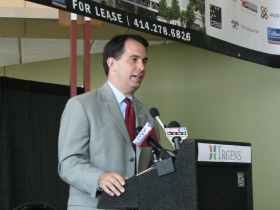What Will “No Recall” Voters Do on Nov. 4?
They didn’t believe a governor should be recalled in mid-term. But will they vote to reelect Walker?
The call to me came on a recent Sunday mid-afternoon, asking: Did you vote for Republican Gov. Scott Walker in 2010? For Walker in his 2012 recall election? Did you vote for him in the recall election because you did not think a governor should be recalled?
Nobody who gets calls like this knows whether it’s a pro- or anti-Walker group doing the dialing, since groups placing the calls now all have feel-good, meaningless names. And, if you ask who is paying for this survey, the caller often hangs up.
But whoever was calling that Sunday was focused on the “no recall” voter, who – separate from what they thought about the controversies Walker created in 2011 – voted to keep him in office in June 2012. “No recall” voters did not believe that a governor should be removed from office mid-term, absent criminal acts or misconduct.
That recall vote made Walker a historical figure; he is the only governor in U.S. history to survive a recall election.
Nobody knows how many “no recall” voters there were in June 2012. Vote totals only invite speculation about the number of “no recall” voters, and how they feel about Walker now. But, in a race that every national and state poll says is a too-close-to-call, “no recall” voters will play a key role in determining whether Walker is re-elected on Nov. 4.
In the June 2012 recall election, Walker kept his job with 1.335 million votes – 175,000 (or 18 percent) more votes than he got in November 2010. Walker’s winning margin in the recall was 53.4 percent, or more than when he was first elected. Barrett, meanwhile, got 1.164 million votes – 160,000 (or 16 percent) more than the Democrat got two years earlier.
One more set of numbers for anyone wondering how many “no recall” voters there were in 2012: 2.5 million votes were cast in the recall election, or 57.8 percent of those over age 18. That was 331,000 more votes than were cast in the November 2010 election for governor, when 49.7 percent of all voting-age residents participated. The turnout in the recall was at an historic high: Government Accountability Board records say between 37.8 percent and 57.8 percent of voting-age residents voted in elections for governor between 1990 and the 2012 recall.
Did “no recall” voters boost the much higher turnout in the June 2012 historical referendum on whether Walker should remain governor? Some math exercises may hint at some possible conclusions:
*If 2.5 million voters – the same number in the recall – cast ballots in the Nov. 4 election for governor, and 2 percent of them were “no recall” voters in 2012, they will cast 50,000 votes.
*If 2.3 million voters – a number midway between the 2010 and 2012 elections – cast ballots for governor on Nov. 4, and 3 percent of them were “no recall” voters in 2012, they will cast 69,000 votes.
*If 2.1 million voters – the same number as 2010 – cast ballots in the Nov. 4 race for governor, and 5 percent of them were “no recall” voters in 2012, they will cast 105,000 votes.
UW-Madison Political Science Professor Ken Mayer, who testified in a state lawsuit that about 331,000 voting-age adults may not have the required photo ID to vote, refused to estimate the number of “no recall” voters in 2012. “There’s no way to tell,” Mayer said in a WisconsinEye interview.
Mayer’s “nightmare scenario” is this: The number of absentee ballots sent out before federal judges reinstated the photo ID requirement, but not counted because those absentee voters never resubmitted their ballots with the required photo ID, turns out to be bigger than the winning margin of either Walker or Burke. If that happens, Mayer added, “We probably have litigation.”
One reason why Mayer throws out that possibility: The percentage of absentee ballots statewide doubled – from 10 percent to 21 percent – between the 2010 election for governor and 2012 election for President. That’s a huge number of voters in any race, much less one that polls have repeatedly shown is too close to call.
Steven Walters is a senior producer for the non-profit public affairs channel WisconsinEye. Contact him at stevenscwalters@gmail.com
The State of Politics
-
RNC Brings Fame to Gen Z Party Leader
 Jul 15th, 2024 by Steven Walters
Jul 15th, 2024 by Steven Walters
-
Wisconsin’s Republican Roots Run Deep
 Jul 8th, 2024 by Steven Walters
Jul 8th, 2024 by Steven Walters
-
Feuding Supreme Court Justices Need a Break
 Jul 1st, 2024 by Steven Walters
Jul 1st, 2024 by Steven Walters























Under Walker Wisconsin is 47th in education funding and 48th in job creation. Put these two facts together, where is our future workforce going to come from? Wisconsin has no high technology jobs. Walker has failed to look at the future. Under Walker we are looking at a 1.8 billion dollar shortfall. Meanwhile he has cut taxes for the rich. Where does he think this money to fund the government is coming from?
“Wisconsin has no high technology jobs.”
That’s news to me. I’m a software engineer and I work in Wisconsin. Look closer and you’ll see high technology jobs — they’re just hidden behind the scenes.